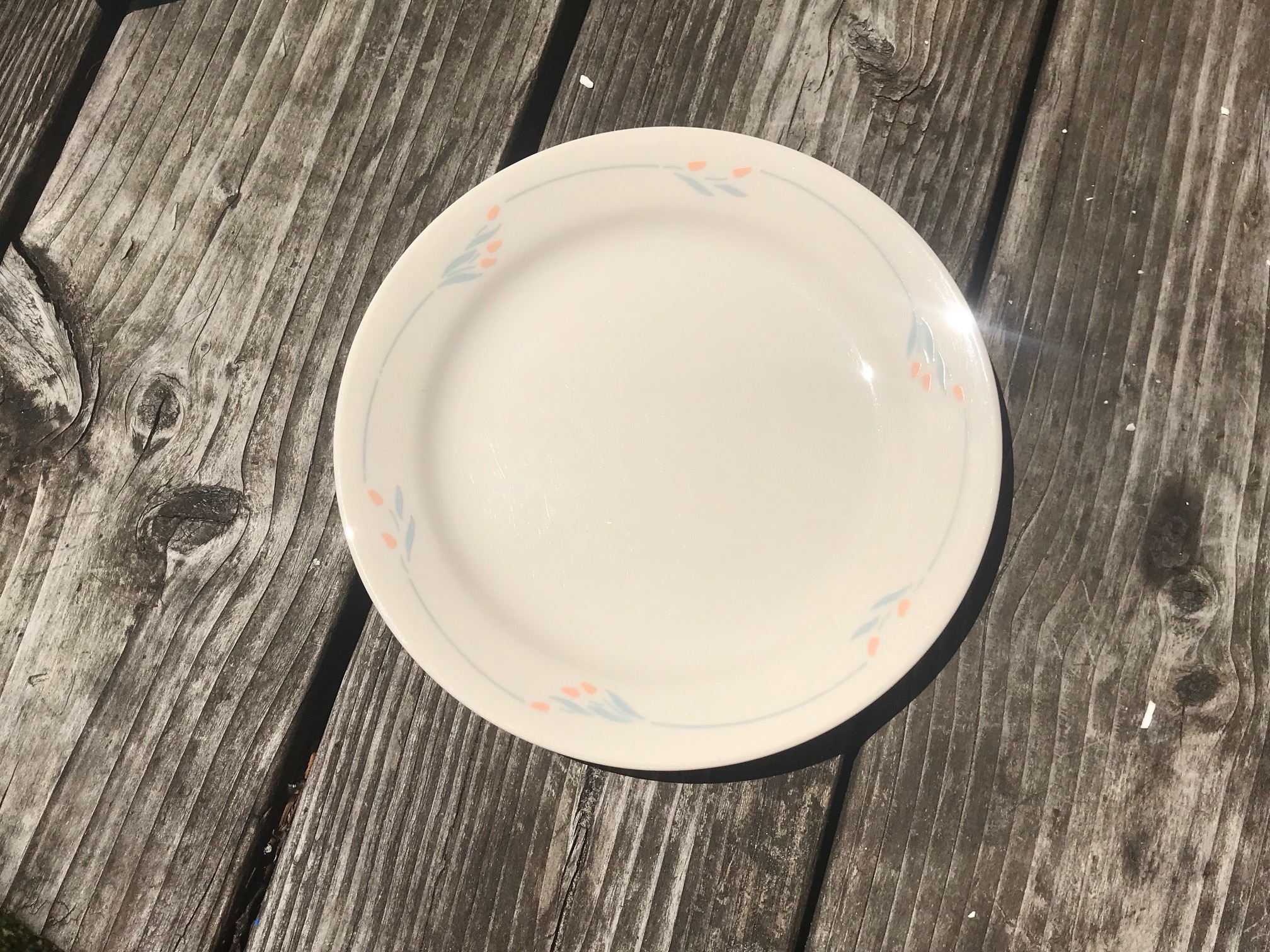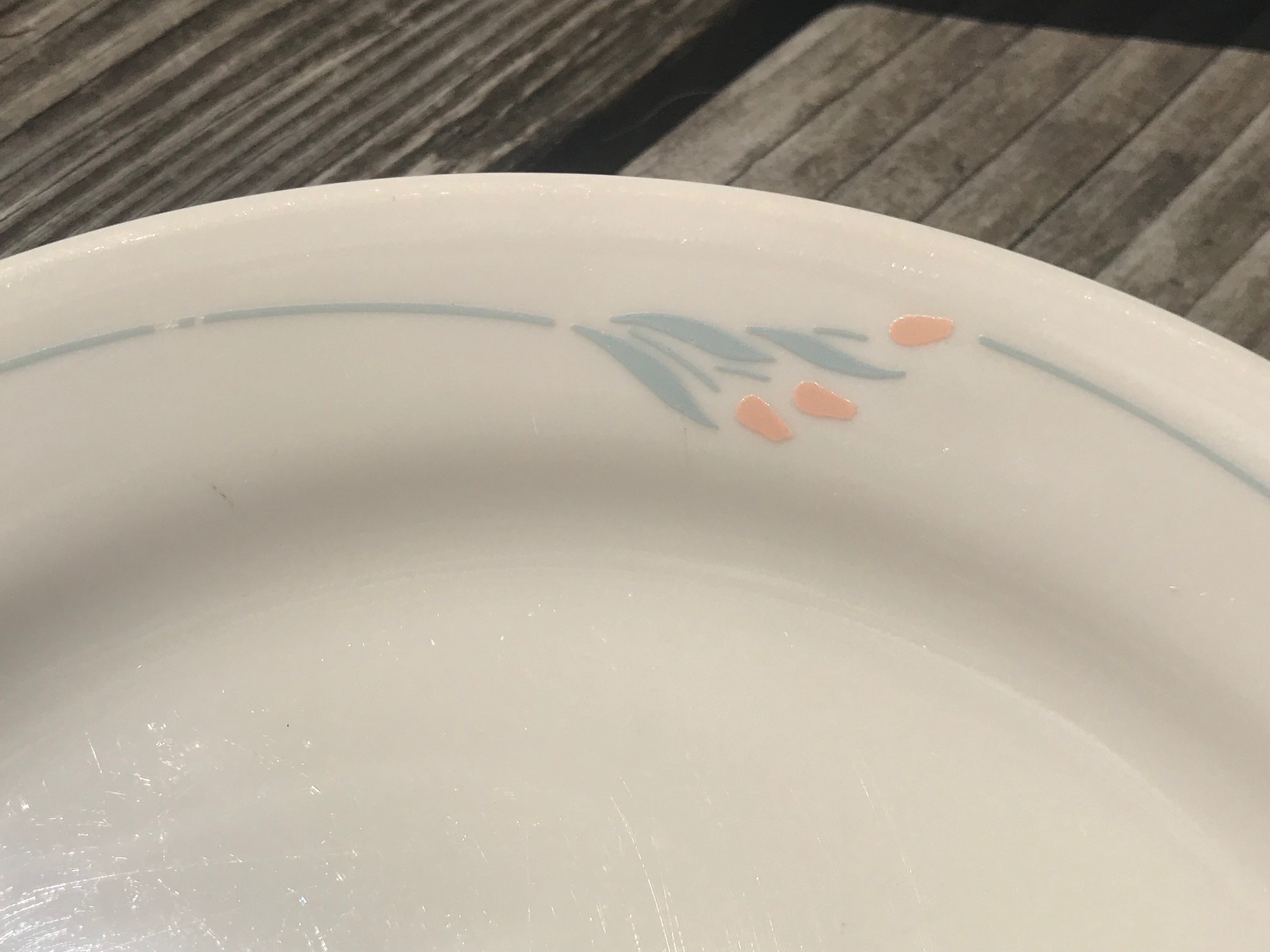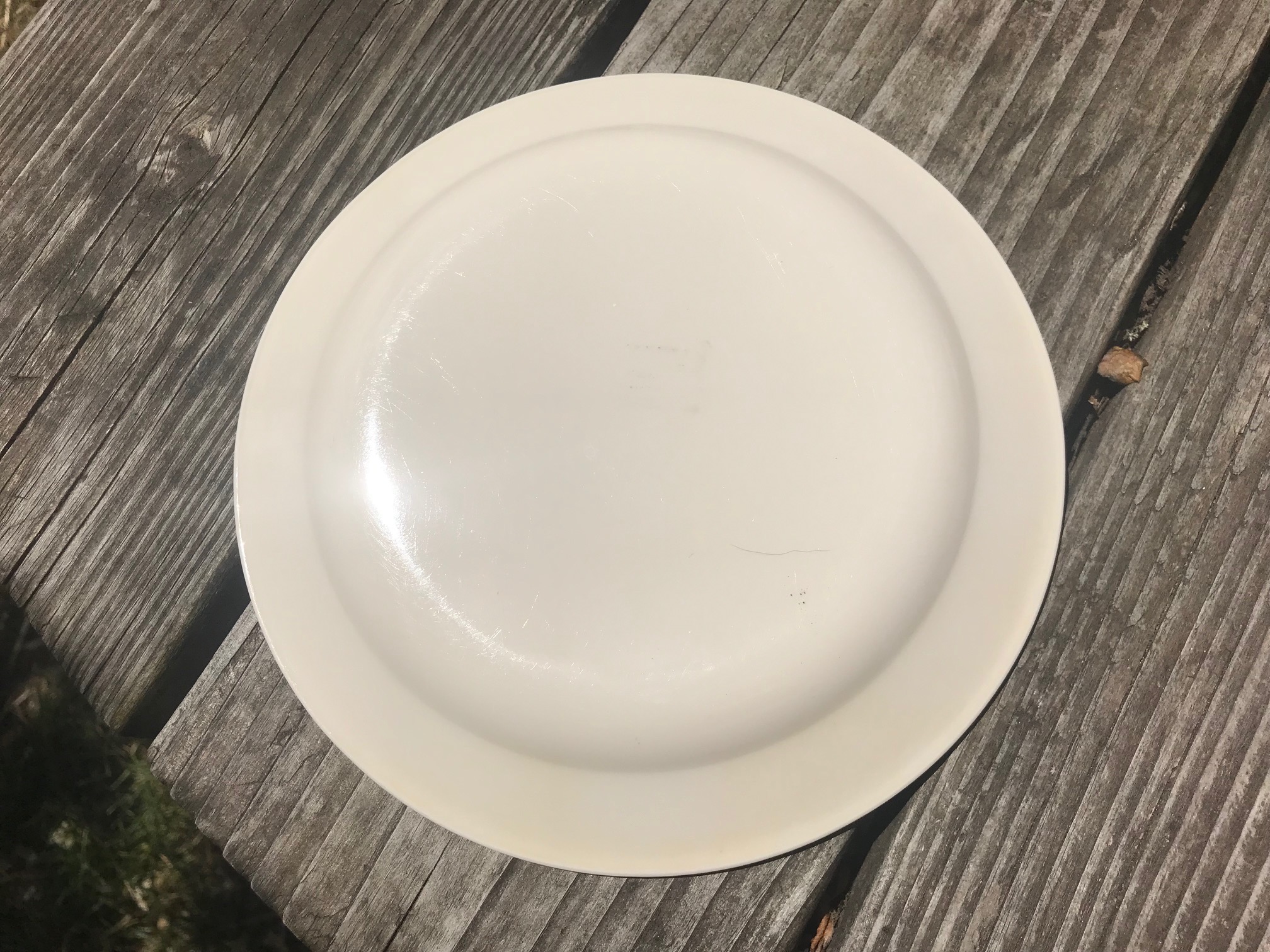Vintage Cream Corelle Plate With Peach Tulip Buds: 28,500 ppm Lead (90 is unsafe for kids) + 150 Cadmium
For those new to this website:
Tamara Rubin is a federal-award-winning independent advocate for consumer goods safety and a documentary filmmaker. She is also a mother of Lead-poisoned children, her sons were acutely Lead-poisoned in 2005. Since 2009 Tamara has been using XRF testing (a scientific method used by the U.S. Consumer Product Safety Commission) to test consumer goods for toxicants (specifically heavy metals), including Lead, Cadmium, Mercury, Antimony, and Arsenic. All test results reported on this website are science-based, accurate, and replicable. Items are tested multiple times, to confirm the test results for each component. Tamara’s work was featured in Consumer Reports Magazine in February of 2023.
To see more Corelle pieces we have tested, click HERE.
Vintage Cream Glass Corelle Plate With Peach Tulip Bud Pattern
(year of manufacture unknown).
When tested with an XRF instrument, the painted decorative border of this vintage Corelle plate was positive for a very high level of Lead. To see the full XRF readings for this exact plate, scroll down. Note: I don’t know the exact year of manufacture of this piece. If you have information about the year of manufacture (or year range) for this pattern, please comment below on the article.
To learn more about XRF testing, click HERE.
As a mother of Lead-poisoned children and as an environmental activist, I have taken the stance that there is no place for any amount of Lead on our dining tables. None at all.
It literally just takes a microscopic amount of Lead to poison a child (or any human for that matter) and, as of the moment of publishing this, there is NO ONE studying the potential impact that eating off of Leaded vintage dishware has on the users (because no corporation stands to benefit financially from such a study). Consequently, we need to err on the side of prudence and proactively remove all potential sources of Lead exposure from our homes ourselves — starting with our kitchens.
For a pretty Lead-free & Cadmium-free modern option, click HERE.*
These particular dishes tested positive for 28,500 ppm Lead.
For context, to better understand what this level of Lead means: the amount of XRF detectable Lead considered toxic in a newly manufactured item “intended for use by children” is anything 90 ppm Lead or higher in the paint, finish, or coating, and anything 100 ppm Lead or higher in the substrate.
Dishes (modern or vintage) are not considered to be items “intended for use by children,” and thus are not regulated for total Lead content (as detectable with an XRF) in the same way as toys and other similar children’s items (unless they are dishes expressly manufactured, marketed and sold as baby dishes after 2010).
To read more about the concern for XRF-detectable Lead in dishware, click here.
Related: What should I do if my dishes are positive for high levels of lead? Click HERE.
All tests reported on this website were done for at least 60 seconds each (unless otherwise noted), using an XRF instrument. The XRF instrument used in the testing is a Niton XL3T, a scientific instrument specifically designed and intended for testing consumer goods for Lead and other metals. The results are science-based, replicable, and accurate.
Decorative Edge/ Food Surface (image above):
- Lead (Pb): 28,500 +/- 700 ppm
- Cadmium (Cd): 150 +/- 16 ppm
- Zinc (Zn): 225 +/- 38 ppm
- Nickel (Ni): 420 +/- 91 ppm
- Iron (Fe): 338 +/- 146 ppm
- Titanium (Ti): 10,100 +/- 500 ppm
- Indium (In): 39 +/- 16 ppm
- Zirconium (Zr): 2,757 +/- 99 ppm
- Platinum (Pt): 463 +/- 131 ppm
Plain Cream Plate Center/ Food Surface:
- Nickel (Ni): 166 +/- 67
- Iron (Fe): 405 +/- 132 ppm
To learn more about the concern for Cadmium (Cd), which is a known carcinogen, click HERE. XRF detectable Cadmium is considered toxic at levels as low as 40 ppm (and above).
As always, please let me know if you have any questions. Thank you for reading and sharing our articles!
Tamara Rubin
#LeadSafeMama
*Some links are Amazon affiliate links. If you purchase something after clicking on one of my affiliate links I may receive a small percentage of what you spend at no extra cost to you. Thank you for supporting independent consumer goods testing in this way!

Never Miss an Important Article Again!
Join our Email List













I had these Corelle dishes in 1989. I think I purchased them sometime between 1986 and ‘89.
I have used the cream vintage tulip buds Corelle since 1986 when I purchased them. Is the lead in the plate itself or in the decorations?
Hi Pam, thank you for commenting.
As with most of these vintage glass pieces the high Lead levels are in the painted decorative elements.
Tamara
Here’s the response from Corelle :
The food surface contact testing was designed to identify whether any small amount of lead that may have existed in pre-2000 manufactured Corelle product leaches from the product in amounts above today’s acceptable lead-safety regulations. The small amount of lead used in decorations pre-2000 was encapsulated in glass before and after the decoration was applied to product and fired to above 750C. The Corelle manufacturing process has always encapsulated decoration in glass, using extremely high processing temperatures to ensure the glass decorations are sealed, which prevents food contact and intentionally decreases the extent of any lead migration to food.
You can see (and read) why this statement is false (politically spun in favor of the corporation) in this article – which has a video to watch that demonstrates the concern: https://tamararubin.com/2022/08/breaking-news-august-2022-corelle-instant-brands-confirms-but-downplays-the-presence-of-leaded-glaze-used-for-the-food-surface-decorations-of-their-vintage-dishware/
Bought these when I got married in 1989. Am still using them. Or at least I was until today.
Hi Paula,
Thanks for the info – having a definite year is very useful info for a lot of my readers!
Tamara
Do cream plates have lead in the cream color?
Do Corelle Sandstone not decorated dishes have lead and cadmium in them? I don’t know when they were manufactured.
Do the sets that are painted cream contain lead also? They were bought in March of 1989. What about the bowl sets that are totally white in the inside but colored on the outside?
I had no idea and was about to buy vintage lunch plates covered in forgetmenots since my kids like smaller plates. Thank you!
I am wondering if our possibly vintage second hand corelle dishware is safe if we only use the white part, eg bowls with flowers on the outside.
I am wondering if our possibly vintage second hand corelle dishware is safe if we only use the white part, eg bowls with flowers on the outside.
You will still handle the outside, and washing will spread the contaminants, as will stacking them.
I, too, bought this pattern in the mid 1980s and am still using them…until now. No more!
We also have the plain cream colored set with no painted designs, also from the 1980s. Hoping they’re safe!
I found the name of this pattern on http://www.replacements.com
Description: Corelle, Peach Flowers, Ivory Background
Pattern: Windflower (Corelle) by Corning
Status: Discontinued.
Thank you!
I had a set of “Rose” pattern, same colors, similar pattern, until my kids left home. My son has hand tremors, and my daughter fits these symptoms from the 2007 article you reprinted:
“… They found that intellectual impairment — brain damage — was number one, but they also found:
** Reduced height and head circumference as blood lead levels rise above 1 ug/dL.
** Delayed sexual maturation. Two studies observed late puberty in girls with blood lead levels in the range of 2 to 5 ug/dL. This seems to indicate that lead is interfering with the endocrine (hormone) system.
** Dental caries (popularly known as “cavities” in teeth) were more likely to develop as a child’s blood lead level rose from 1 to 3 ug/dL.
And a study too recent to have been included in the Appendix has shown that a child is 4 times as likely to have attention deficit hyperactivity disorder (ADHD) when blood lead levels reached 2 ug/dL or greater, compared to children with lead at 1 ug/dL. …”
I received these dishes in 1981 as a present. Have used them ever since.
So sad to know they are not safe.
So are the plain, white, undecorated ones OK?
Wow, I got these as wedding gift in April of 1986 and yes I still use them everyday. I’m kinda blown away by this. Thanks for the article.
Please need an answer. Are the older plates 1990 of 1) white plain plate only without decorative – is it ok to use? 2) beige plain color only without any decorative – is it ok to use?
The plain white and beige Corelle brand products (with no painted decorative markings) from any year of manufacture consistently test either Lead-free or at least Lead-safe (below 90 ppm Lead.) Both would be considered safe by all modern standards.
Tamara